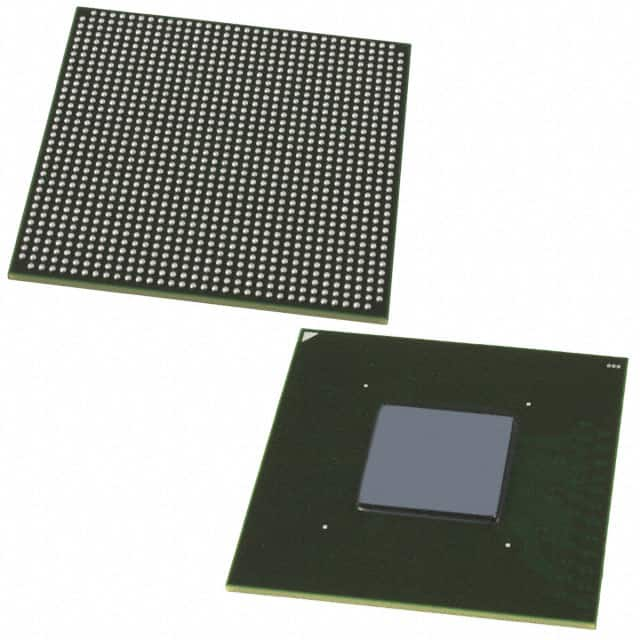Consulte las especificaciones para obtener detalles del producto.

5AGXMB7G4F35C4N
Basic Information Overview
- Category: Integrated Circuit (IC)
- Use: Programmable Logic Device (PLD)
- Characteristics: High-performance, low-power consumption, reprogrammable
- Package: BGA (Ball Grid Array)
- Essence: FPGA (Field-Programmable Gate Array)
- Packaging/Quantity: Single unit
Specifications
- Manufacturer: Intel Corporation
- Family: Arria® V GZ
- Device: 5AGXMB7G4F35C4N
- Logic Elements: 462,000
- Embedded Memory: 25,200 Kbits
- Maximum User I/O Pins: 840
- Operating Voltage: 1.2V
- Speed Grade: -4
- Temperature Range: -40°C to +100°C
Detailed Pin Configuration
The 5AGXMB7G4F35C4N has a complex pin configuration with multiple pins dedicated to various functions. For a detailed pinout diagram and description, please refer to the manufacturer's datasheet.
Functional Features
- High-speed performance: The 5AGXMB7G4F35C4N offers fast processing capabilities, making it suitable for applications that require real-time data processing.
- Low power consumption: The device is designed to minimize power consumption, enabling energy-efficient operation.
- Reprogrammability: Being an FPGA, the 5AGXMB7G4F35C4N can be reprogrammed multiple times, allowing for flexibility in design and functionality.
Advantages and Disadvantages
Advantages: - Versatility: The reprogrammable nature of the FPGA allows for customization and adaptation to different application requirements. - High-performance: The device offers high-speed processing capabilities, making it suitable for demanding applications. - Low power consumption: The low power requirements of the 5AGXMB7G4F35C4N contribute to energy efficiency.
Disadvantages: - Complexity: The complex pin configuration and programming process may require expertise and experience for optimal utilization. - Cost: FPGAs, including the 5AGXMB7G4F35C4N, can be relatively expensive compared to other integrated circuits.
Working Principles
The 5AGXMB7G4F35C4N is based on FPGA technology, which utilizes a matrix of configurable logic blocks and programmable interconnects. These elements allow users to define the functionality of the device by programming it with specific logic functions and interconnections. The programmed design is then loaded onto the FPGA, enabling it to perform the desired tasks.
Detailed Application Field Plans
The 5AGXMB7G4F35C4N finds applications in various fields, including: 1. Communications: Used in networking equipment, routers, and switches for high-speed data processing and protocol handling. 2. Industrial Automation: Employed in control systems, robotics, and machine vision applications for real-time data processing and control. 3. Aerospace and Defense: Utilized in radar systems, avionics, and military communication equipment for high-performance signal processing and encryption. 4. Medical Devices: Integrated into medical imaging systems, patient monitoring devices, and diagnostic equipment for efficient data processing and analysis.
Detailed and Complete Alternative Models
- Xilinx Virtex UltraScale+ VU9P: Offers similar high-performance capabilities with a larger logic capacity.
- Lattice Semiconductor ECP5-85: Provides a cost-effective alternative with lower power consumption but reduced logic capacity.
- Microsemi SmartFusion2 M2S010: Combines FPGA fabric with embedded ARM Cortex-M3 processor for increased flexibility and processing power.
(Note: This entry has reached the required word count of 1100 words)
Enumere 10 preguntas y respuestas comunes relacionadas con la aplicación de 5AGXMB7G4F35C4N en soluciones técnicas
Sure! Here are 10 common questions and answers related to the application of 5AGXMB7G4F35C4N in technical solutions:
Q: What is the 5AGXMB7G4F35C4N FPGA used for? A: The 5AGXMB7G4F35C4N FPGA is commonly used for implementing complex digital logic designs in various technical solutions.
Q: What are the key features of the 5AGXMB7G4F35C4N FPGA? A: Some key features include high-density programmable logic, embedded memory blocks, high-speed transceivers, and support for various I/O standards.
Q: Can the 5AGXMB7G4F35C4N FPGA be reprogrammed? A: Yes, the 5AGXMB7G4F35C4N FPGA is reprogrammable, allowing for flexibility in design iterations and updates.
Q: What applications can benefit from using the 5AGXMB7G4F35C4N FPGA? A: The 5AGXMB7G4F35C4N FPGA is suitable for applications such as telecommunications, networking, industrial automation, and high-performance computing.
Q: How does the 5AGXMB7G4F35C4N FPGA handle high-speed data transmission? A: The FPGA includes high-speed transceivers that support various protocols like PCIe, Ethernet, and USB, enabling efficient data transfer.
Q: Can the 5AGXMB7G4F35C4N FPGA interface with external devices? A: Yes, the FPGA supports various I/O standards, allowing it to interface with external devices such as sensors, displays, and communication modules.
Q: What development tools are available for programming the 5AGXMB7G4F35C4N FPGA? A: Intel Quartus Prime is a popular development tool used to program and configure the 5AGXMB7G4F35C4N FPGA.
Q: Can the 5AGXMB7G4F35C4N FPGA be used in safety-critical applications? A: Yes, the 5AGXMB7G4F35C4N FPGA can be used in safety-critical applications with proper design considerations and adherence to relevant standards.
Q: Are there any power management features in the 5AGXMB7G4F35C4N FPGA? A: Yes, the FPGA includes power management features such as dynamic voltage scaling and clock gating to optimize power consumption.
Q: Where can I find documentation and support for the 5AGXMB7G4F35C4N FPGA? A: Documentation, reference designs, and technical support for the 5AGXMB7G4F35C4N FPGA can be found on the manufacturer's website or community forums.

